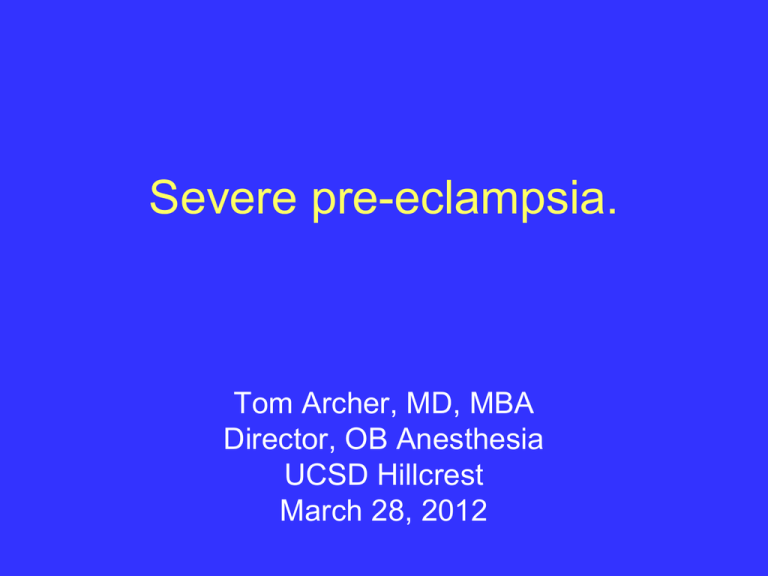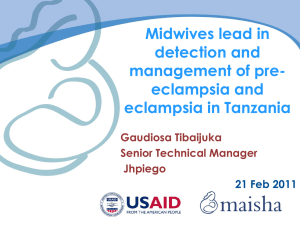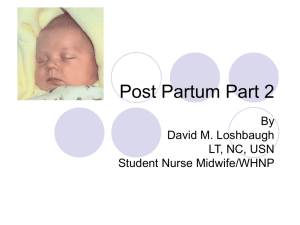Pre-eclampsia - UC San Diego Health Sciences
advertisement

Severe pre-eclampsia. Tom Archer, MD, MBA Director, OB Anesthesia UCSD Hillcrest March 28, 2012 Hypertension in pregnancy • Pre-eclampsia (HBP, proteinuria, edema, after 20 weeks ega) • Gestational hypertension (HBP after 20 weeks ega, no proteinuria). Old term: “pregnancy-induced hypertension”. • Chronic hypertension (HBP antedating pregnancy). • “Superimposed” pre-eclampsia– pre-eclampsia on top of chronic hypertension Three causes of death in pregnancy: #1 Pulmonary thromboembolism #2 Hemorrhage #3 Hypertensive disorders / pre-E Stroke Seizures DIC Pre-eclampsia variants • Eclampsia– pre-eclampsia with seizures • HELLP syndrome (hemolysis, elevated liver enzymes and low platelets) Severe pre-eclampsia • SBP > 160 or DBP > 110, X2, 6 hours apart. • Proteinuria > 5 gm / 24 hours (Hence 24hour urine collection) • Oliguria < 500 mL / 24 hours Severe pre-eclampsia • Cerebral or visual disturbances: HA, blurred vision or altered consciousness. • Pulmonary edema (or low Sp02). • Epigastric or RUQ pain (liver edema or rupture) Severe pre-eclampsia • Increased liver enzymes-- common. • Prolonged PT or PTT or decreased fibrinogen implies DIC– fortunately rare. • Thrombocytopenia • Fetal growth restriction Traditional pre-eclampsia triad: • Hypertension • Proteinuria • Edema New understanding of traditional pre-eclampsia triad: • Hypertension arteriolar constriction (endothelial dysfunction). • Proteinuria leaky glomerulus (capillary) (endothelial dysfunction). • Edema leaky capillaries in skin, muscle, liver, brain, airway, nose. (endothelial dysfunction). “4th component” of endothelial dysfunction in pre-eclampsia • Muscular artery spasm increased arterial wave reflection back to heart • Increased “augmentation index” (AIx) • Increased AIx extra work for heart muscle • LVH, increased BNP release CHF. Modern concept of pre-eclampsia: symptoms are due to arterial, arteriolar and capillary endothelial damage. Q: Damage by what? A: Chemical mediators from placenta “Toxemia of pregnancy” • The old-fashioned term is actually very descriptive! • The ischemic placenta gives off toxins which damage the mother’s vascular endothelium throughout her body. Pre-eclampsia: ischemic chorionic villi release pre-E mediators into maternal blood. Say “OUCH!” Pre-E mediators Poor placentation www.siumed.edu/~dking2/erg/images/placenta.jpg Pre-E: endothelial damage • Deranged smooth muscle function, due to damaged endothelium overlying smooth muscle. • Leaky capillary endothelium (no smooth muscle). Endothelial cells send molecular signals to surrounding smooth muscle Pre-eclampsia mediators (and glucose) make endothelium produce Insulin makes endothelium produce Vessel lumen vasoconstrictive signals (thromboxane, endothelin) Archer TL 2006 unpublished, Idea from Dandona P 2004 vasodilatory signals (NO, prostacyclin) Endothelial factors in pre-E: • In health, there is a balance between – vasodilatory factors: NO, PGI2 (Prostacyclin) and – vasoconstrictive factors: thromboxane, endothelin. • This normal balance is messed up in pre-E. Obesity, hyperglycemia, sepsis and pre-eclampsia all “activate” (damage) endothelium, white cells and platelets, leading to white cell adhesion and infiltration, thrombosis and edema (inflammation). WBC WBC Obesity, hyperglycemia, sepsis or pre-eclampsia Platelet Platelets Capillary endothelium (no underlying smooth muscle) Protein (edema) Archer TL 2006 unpublished Endothelial damage causes problems in 3 sizes of blood vessels: • Muscular arteries increased wave reflection (heart work, augmentation index). • Arterioles increased SVR • Capillaries proteinuria and tissue edema (glomerulus, liver, skin, muscle, brain) Figure 1. Pt HB, PreE for CS, superimposed on CHTN and CRF, 33 weeks. Hemodynamic parameters before and after treatment with antihypertensive medication A. Labetalol 25 mg and hydralazine 5 mg, B. Nicardipine 250 μ total in divided doses Nominal cardiac output L/min 8 4 0 Nominal systemic vascular resistance dyn.sec.cm-5 3000 2000 1000 0 Blood pressure mm Hg 200 100 0 150 Heart rate beats/min and nominal stroke volume mL 100 50 0 0 10 A 20 minutes 30 B 40 Posterior reversible encephalopathy syndrome (PRES): Occipital-parietal cortical and white matter changes in pre-eclampsia. Is this due to capillary damage in the brain? Port JD, Beauchamp RadioGraphics 1998; 18:353-36ı ‘ Figure 1b Figure 1c Edema– imagine same process in liver and brain! Pre-eclampsia: Probably a disorder of placentation. Poor-placentation theory of pre-E: Synciotrophoblast invades myometrium but does not denervate spiral arteries of mother properly. Hence, intervillous flow is suboptimal. Chorionic villi are ischemic and release mediators (VEGF, etc) which damage maternal endothelium. http://pharyngula.org/images/preeclampsia_model.jpg Pre-eclampsia: ischemic chorionic villi release pre-E mediators into maternal blood. Say “OUCH!” Pre-E mediators Poor placentation www.siumed.edu/~dking2/erg/images/placenta.jpg Hemodynamic review: MAP = SVR x CO. We ignore CVP since it is small compared to MAP. Hemodynamic issues in pre-eclampsia • We could work on CO or SVR, since MAP = CO x SVR. We usually work on both CO and SVR, but different drugs affect the two components to different degrees. SAB / epidural cause sympathectomy www.cvphysiology.com/Blood%20Pressure/BP019.htm Post-partum BP control • Hydralazine – arteriolar vasodilator. Decreases SVR. Tendency is to cause tachycardia. 5 mg IV q15 minutes • Labetalol – alpha and beta blocker. Dilates arterioles (dec SVR) and slows heart rate and reduces contractility (dec CO). 10-20 mg IV q 10 minutes. Why treat BP in pre-eclampsia? • Decrease stroke, CHF, renal damage? • This has never been proven by RCT. • But we do it anyway! • Goal is modest decrease in BP. DBP 90100 mm Hg. Other BP meds in pre-eclampsia • Nitroglycerin– venodilator, can be given sublingually or IV. • Sodium nitroprusside– IV. Needs arterial line.Primarily arteriolar dilator. • Nifedipine– Ca++ channel blockers. Arteriolar dilator. Can be used for BP control and also as a tocolytic. Caution should be used when used with Mg++. • Esmolol– sort acting beta blocker. Adjunct to decrease HR in BP control. Pre-eclampsia complication: pulmonary edema • Fluid overload / pulmonary edema– – respiratory distress – Low SpO2 (“low sats”) – Rales on auscultation • Can progress to ARDS • May need intubation • Call anesthesia for evaluation Pre-eclampsia complications: pulmonary edema • Fluid overload / pulmonary edema– – Albumin (oncotic pressure) decreases in normal pregnancy. – Lower in pre-eclampsia due to protein loss into interstitial space Respiratory function in pre-eclampsia • Edema of the airway Pre-eclampsia complications: blindness and seizures • Blindness / blurred vision – Edema in occipital cortex (retina is normal) – Disorientation / fear – Visual impairment usually resolves completely Pre-eclampsia complications: blindness and seizures • Seizure: neurological event but also a respiratory event! • Remember: suction, oxygen, ambu bag, IV access, call anesthesiologist to help. • Ante-partum, fetal oxygenation is at risk. MgSO4 seizure prophylaxis • Mg++ in severe pre-E reduces seizures by about 60% (from 1.9% 0.8%) • Mg++ use in mild pre-eclampsia is controversial but it is used at UCSD. Magnesium toxicity • 1.7-2.4 mg / dL– Normal • 5-9 mg / dL– therapeutic range for seizure prevention • Loss of patellar reflexes (but watch out for epidural)– 12 mg / dL • Respiratory arrest – 15-20 mg / dL • Asystole– 25 mg / dL • Mg++ levels OK, but try clinical assessment! Magnesium toxicity • Multiple blood draws– think central or arterial line or blue valve from IV catheter. Avoid repeated sticks? • Treatment: • Stop Mg++ • Give Ca++ (1 gm Ca gluconate or 300 mg CaCl2 • Assist ventilation (Ambu bag). Intubation if necessary. Magnesium toxicity • Uterine atony (Mg++ is a uterine relaxant) Hematologic aspects of pre-E: • Exacerbated normal hypercoagulability of normal pregnancy. If DIC occurs, fibrinolysis will occur as well (+ Fibrin dimer test) Platelet activation and adhesion / consumption. We commonly follow trend of platelets. Regional OK if > 50-100K. Prolongation of PT / PTT or decreased fibrinogen in pre-E • Uncommon (thrombocytopenia is common). • Low fibrinogen implies DIC. • Liver damage decreased synthesis of fibrinogen and clotting factors? • Bottom line: if fibrinogen or PT/PTT are abnormal, patient has a more serious problem than “just” thrombocytopenia. Pre-eclampsia complications • Disseminated intravascular coagulation (“DIC”) – Consumption of platelets and clotting factors d/t damaged endothelium – Diffuse ooze from incision, IV sites – Major emergency – IV access, pRBCs, FFP, cryoprecipitate – Will need ICU, ?intubation, arterial line Hemolysis from fibrin stands www.nejm.org/.../2005/20050804/images/s19.jpg Liver in pre-eclampsia • Elevated liver enzymes (AST, ALT) • Edema– swelling– epigastric / RUQ pain • Hemorrhage into liver (hematoma) • Rupture of hematoma through liver capsule (“liver rupture”). Factitious thrombocytopenia • Platelet clumping due to EDTA anticoagulant or cold www.nejm.org/.../2005/20050804/images/s19.jpg Renal function in pre-eclampsia • Normal pregnancy involves increased GFR and decreased creatinine, e.g. 0.80.6 mg/dL. • Renal dysfunction in pre-eclampsia may be associated with a “normal” creatinine, eg. 1.0. • Increased uric acid in pre-eclampsia Renal failure after pre-E • Oliguria almost always gets better after delivery. • Renal failure due to pre-E is rare (unless there is pre-existing renal disease). Oliguria • Urine output less than 30 mL / hr for more than 3 hours, despite crystalloid boluse(s) of 300-500 mL. • Is the Foley in the bladder? Is it kinked? Summary • Pre-eclampsia is associated with endothelial dysfunction. • Normal balance between vasodilation and vasoconstriction tips toward constriction. • Capillaries become leaky– edema (and proteinuria) everywhere. Summary • Old-fashioned term “toxemia of pregnancy” is very accurate! • Placenta is ischemic because implantation has not gone well. • Pre-eclampsia: a disorder of implantation. Summary • Pre-eclampsia may involve an early hyperdynamic phase (increased CO), followed by a vasoconstrictive phase (high SVR). • Later on, pre-eclampsia involves intense arteriolar constrictive, with high BPs and reflected pressure waves leading to heart strain and possible CHF. Summary • The endothelial damage of pre-eclampsia can activate the coagulation system. • Thrombocytopenia occasionally occurs but hypofibrinogemia and prolonged PT/PTT are rare and very worrisome. Overall management • • • • • Seizure prophylaxis Hemodynamic state—invasive monitoring Fluid restriction (but boluses for oliguria). Review of platelets, PT, PTT, fibrinogen Evaluation of airway (swelling) and pulmonary status (edema) • Pulmonary edema most common after delivery (mobilization of edema fluid). Neonatal issues in pre-eclampsia • IUGR • Prematurity • Hypoxia • Mother will be afraid for the baby! Maternal CNS issues in pre-eclampsia • Confusion or somnolence due to cerebral edema • Somnolence due to MgSO4 therapy • Post-ictal state (has patient had a seizure?) • Is patient afraid? Summary care for patient with severe pre-eclampsia • Emotional support– anxiety for self, neonate, CNS changes due to disease and therapy. • Pain from surgery– helped by neuraxial anesthesia and neuraxial opioids. Summary of care for patient with severe pre-eclampsia • Follow BP– may increase as spinal wears off. This is normal. • Goal of BP control is high normal– don’t overshoot. • Treat pain, not just give antihypertensives. Summary of care for patient with severe pre-eclampsia • Judicious fluid restriction (unless postpartum hemorrhage). • Continue magnesium sulfate. • Monitor urine output. Summary of care for patient with severe pre-eclampsia • Monitor for post-partum hemorrhage • Prolonged labor, MgSO4 can predispose to uterine atony. • Monitor for DIC. Oozing at IV and other venipuncture sites. How can anesthesiologist help the patient in the PACU? • IV access: central line or arterial line for repeated blood draws and BP monitoring? • IV med assistance: what to give? How fast will it work? • Monitor for pulmonary / cardiac dysfunction– rales, low Sp02. How can anesthesiologist help the patient in the PACU? • Manage seizing patient– airway, vomiting. • Have suction, ambu bag, crash cart nearby. The End








